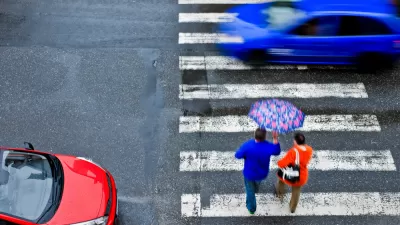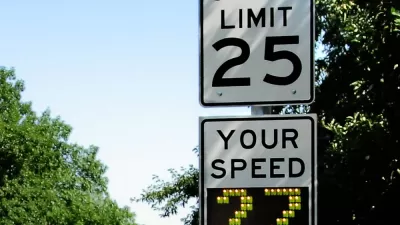The Insurance Institute for Highway Safety released a study on May 8 that attributes the increased number of pedestrians killed in part to road design that allows for higher speeds, fewer intersections and pedestrian crossings and more SUVs.

Nearly 6,000 pedestrians, the most since 1990, "were killed in 2016, up 46 percent from 2009, when such deaths were at a low point, the Insurance Institute for Highway Safety (IIHS) said in a report issued Tuesday," reports Fredrick Kunkle for The Washington Post on May 8. By contrast, total traffic fatalities increased 11 percent over the same period.
The report — which analyzed federal crash data from 2009 to 2016, along with details related to the type of roadway, vehicle and other factors — says 5,987 pedestrians died in crashes in 2016, or about 16 percent of all traffic deaths.
The Governors Highway Safety Association acknowledged the IIHS report, and urged that public awareness campaigns be aimed at reducing speed and alcohol impairment. The association released their own report on Feb. 28 on pedestrian fatalities in 2017, essentially unchanged from 2016.
"The pedestrian deaths occurred mostly when it was dark and mostly on roads designed to funnel urban or suburban traffic onto freeways, the institute says," continues Kunkle.
The crashes generally occur where there are no intersections or poorly designed crosswalks that tempt pedestrians to dash across multiple lanes of swiftly moving vehicles. The crashes often involved SUVs or vehicles with a lot of horsepower, which suggests that many of the crashes also involved excess speed.
SUVs are implicated in another manner, by having a higher and more vertical front end, according to the status report on the study.
Finally, vehicle design changes could help lessen the severity of crashes, especially when it comes to SUVs. These make up an increasingly large percentage of registered vehicles, and previous studies have found that SUVs, pickups and vans are associated with a higher risk of death or severe injury to pedestrians.
Such vehicles have higher and often more vertical front ends than cars and are more likely to strike a pedestrian in the head or chest. Changes in the front-end design of these vehicles could help lessen the severity of injuries when they strike pedestrians (see "Softer vehicle fronts and pedestrian detection systems could reduce pedestrian deaths, injuries," Dec. 30, 2013).
The three-minute IIHS video, narrated by IIHS President David Harkey, is extremely informative and highly recommended for those working to reduce pedestrian fatalities. Final words go Harkey:
Understanding where, when and how these additional pedestrian crashes are happening can point the way to solutions. This analysis tells us that improvements in road design, vehicle design and lighting and [automated] speed limit enforcement all have a role to play in addressing the issue.
Click here to access the report.
FULL STORY: Pedestrian deaths soar 46 percent, insurance group finds

Alabama: Trump Terminates Settlements for Black Communities Harmed By Raw Sewage
Trump deemed the landmark civil rights agreement “illegal DEI and environmental justice policy.”

Study: Maui’s Plan to Convert Vacation Rentals to Long-Term Housing Could Cause Nearly $1 Billion Economic Loss
The plan would reduce visitor accommodation by 25% resulting in 1,900 jobs lost.

Planetizen Federal Action Tracker
A weekly monitor of how Trump’s orders and actions are impacting planners and planning in America.

Restoring Northern India’s Himalayan ‘Water Temples’
Thousands of centuries-old buildings protect the region’s natural springs and serve as community wells and gathering places.

Milwaukee to Double Bike Share Stations
Bublr Bikes, one of the nation’s most successful, will add 500 new e-bikes to its system.

DC Extends Application Window for Outdoor Dining Permits
District restaurants will have until the end of November to apply, but businesses with permits in rush hour parking lanes must end operations on July 31.
Urban Design for Planners 1: Software Tools
This six-course series explores essential urban design concepts using open source software and equips planners with the tools they need to participate fully in the urban design process.
Planning for Universal Design
Learn the tools for implementing Universal Design in planning regulations.
Caltrans
Smith Gee Studio
Institute for Housing and Urban Development Studies (IHS)
City of Grandview
Harvard GSD Executive Education
Toledo-Lucas County Plan Commissions
Salt Lake City
NYU Wagner Graduate School of Public Service





























